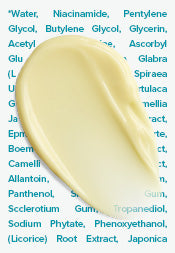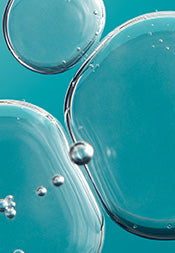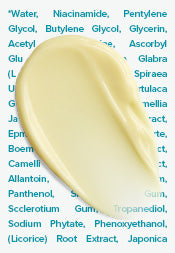How to Get Rid of Red Spots and Acne on Face
Why is my face red?
While acne is a common cause of red spots and bumps, it’s important to distinguish between pimples and other types of facial redness to make sure you’re getting the right skincare treatment.
Acne
Acne-related red spots stem from active pimples, as well as post-blemish marks. On lighter skin tones, these appear pinkish to reddish in hue, but on deeper skin tones these marks typically appear tan or dark brown. Either way, the redness or other discolouration that you see is a result of the skin’s response to the acne-induced inflammation.
What causes acne?
The causes of acne are multifactorial, but on a rudimentary level, typically what happens is an overabundance of sebum (oil) builds up within the pore and as it mixes with dead skin and debris in the pore lining, it forms a thick, waxy clog. This congestion creates the perfect environment for acne-triggering bacteria to flourish, resulting in a pimple.
Other factors that can make acne-prone skin worse include: using products that aren’t right for your skin type and/or contain irritating ingredients, not properly cleansing skin (i.e. falling asleep with your makeup/sunscreen on), stress, certain dietary sensitivities, and hormonal fluctuations.
How to reduce redness on your face
Want to minimise the redness that comes with acne as fast as possible? We’ve been there, too and have a few “instant-relief” hacks up our sleeve that can help. Here’s your quick and easy guide to soothing skin and toning down acne redness (quite literally) on the spot.
Hack 1: Calm skin with soothing ingredients
A pimple is red because it’s irritated, so it stands to reason that anything you can do to soothe skin is going to help visibly minimise the redness.
Our trick? Spot-treat the area with an acne redness treatment containing salicylic acid, which research shows has soothing, anti-inflammatory, anti-redness properties that can help pimples go down. Then follow up with a redness-reducing formula featuring skin-calming extracts such as oat, willow herb, and liquorice. This combination can bring near-instant redness relief.
Hack 2: Get the red out with Visine®
Really short on time? Saturate a cotton swab with Visine® or other “redness-relieving” eye drops (not artificial tears or eye drops for dry eyes) and hold the swab on the affected area for 30 seconds or so. Visine or other similar redness-relieving eye drops contain ingredients that help to constrict blood vessels. It’s an off-label, temporary solution, but anecdotal evidence shows that it works for some people (including a few of our Paula’s Choice Singapore staffers who swear by it when they’re in a pinch). If you already have Visine® or something similar at home, it’s worth a try!
Hack 3: Colour correct and conceal
You can also try neutralising reddened blemishes with a well-formulated green colour corrector product. You’ll need to top it off with a medium-coverage concealer for a natural skin tone effect, but together, this duo can cancel the red right out.
Hack 4: Cortisone shot
If you have a pimple emergency before a big event, see a dermatologist for an intralesional cortisone shot. The diluted steroid shot will help pimples vanish within 24-48 hours!
Above all else, make sure you treat your skin as gently as possible, by using fragrance- and irritant-free products that won’t make redness worse.
Eczema
Eczema looks and feels different than acne and is triggered by a different set of factors. With lighter skin tones, eczema-related redness appears in clusters/patches. On deeper skin tones, it presents as violet to grey or dark brown, often with a bumpy texture. Regardless of skin colour, itching is a major symptom of eczema. If you suspect you may have this condition, it’s imperative to see a dermatologist for diagnosis and to discuss solutions.
Rosacea
Redness related to rosacea presents differently, typically appearing as flushing or blushing that will be most apparent on fair to medium skin tones. This is another condition that must be diagnosed and discussed with a physician for treatment. Note that those with darker skin won’t see rosacea-related redness but will instead see patchy darkening accompanied by a persistent warm, sensitised feeling.
Allergic reactions
Allergic reactions on fair to medium skin may look similar to the red bumps you see with acne. Sometimes these types of reactions happen suddenly after exposure; other times, they take longer to show up. In addition to the redness, allergic reactions may also be accompanied by uncomfortable-feeling, sensitised skin. Those with darker skin tones will potentially see localised discolouration and a bumpy texture, accompanied by an itchy sensation.
What causes allergic reactions?
The causes of allergic reactions vary and can be highly individual. You could experience an allergy to a specific ingredient or combination of ingredients in your skincare product (fragrance ingredients are common triggers). It’s also possible to develop an allergy to products you’ve used for years without issue. This is due to how skin changes over time, including from environmental damage and menopause.
Shop Paula’s Choice Calm range for acne-prone, sensitive skin.
References for this information:
Journal of Clinical and Aesthetic Dermatology, March 2021, pages S20–S22
American Journal of Clinical Dermatology, January 2021, pages 55-65
Molecules, August 2016, ePublication
Phytotherapy Research, February 2014, pages 159–166
Fitoterapia, October 2013, pages 160–184
Clinical Biochemistry, September 2011, pages 1,035-1,040
Seminars in Cutaneous Medicine and Surgery, 2008, pages 170–176
Clinical Dermatology, September 2004, pages 360-366
Recommended Products to Reduce Redness
CLEAR Regular Strength Exfoliating Solution 2% BHA
CLEAR Extra Strength Exfoliating Solution 2% BHA












